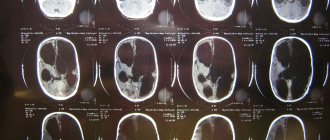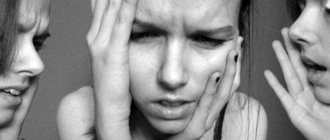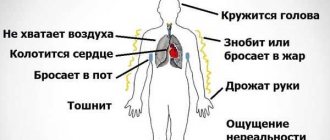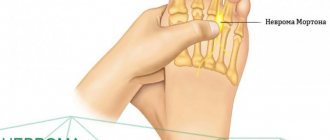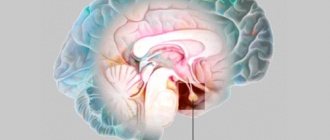Early childhood schizophrenia is a mental disorder that begins in children under three years of age and is manifested by a progressive decline in mental functions.
The famous Soviet psychiatrist V.M. Bashin in his work “Early childhood schizophrenia. Statics and Dynamics” divides the disease into the following age stages:
- early childhood - up to 3 years;
- pre-school - from 3 to 5 years;
- preschool - from 5 to 7 years.
According to Bashina’s observations, in most cases (69%), the onset of schizophrenia in children occurs in the first three years of life.
Causes of development of schizophrenia in children
In childhood, along with the causes assumed in adults, the time of onset of the disease and provoking (trigger) factors play a great role. Common reasons:
- heredity – high risk if there is a disease in the family;
- toxic effects on the embryo during the prenatal period - medicinal, narcotic, alcoholic, ionizing radiation, chemicals;
- stress, infectious, somatic diseases, traumatic brain injury of the mother during pregnancy;
- unfavorable intra- and postnatal period - birth injuries, hypoxia, intracranial pressure, infectious diseases of newborns;
- late-bearing mothers (after 35 years).
Triggering factors can be severe fear of a small child, neuropsychic stress, long-term somatic pathologies, endocrine disorders, improperly performed vaccinations (without due dates, without taking into account side effects and contraindications).
Pathogenesis
The following developmental mechanisms play a role in the pathogenesis of early childhood schizophrenia:
- oxygen starvation of brain cells, especially affecting the period of growth and development of tissues and organs of the child’s nervous system;
- genetic changes due to toxic effects on the embryo - primarily mutations in the short arm of chromosome 6;
- dysfunction of neurotransmitters - increased activity of dopamine, decreased activity of glutamate receptors.
Forms of schizophrenia in children
In young children, the continuous form of schizophrenia predominates, which is divided into malignant, sluggish, and paranoid. The sluggish variant is more common.
One of the features of the course of schizophrenia in childhood is the addition of neurosis-like symptoms, which often leads to a false lead in diagnosis and masks the clinical picture.
The absence of productive symptoms (delusions, hallucinations) causes a rare paroxysmal-progressive form in young children. This form is typical for schoolchildren, and the delirium is rudimentary, monothematic, and systematized in nature. The full picture is observed in adolescence.
Also, almost no recurrent course is observed (only in 5% of cases).
According to clinical manifestations, catatonic and simple schizophrenia are observed in early childhood. Hebephrenic is typical for the puberty period. Paranoid - in rare cases diagnosed in middle school students.
Causes
Medicine cannot yet answer the question unequivocally: where do children get mental disorders
The official version is considered to be a complex of various factors that influence personality development:
- Biological (individual characteristics of the development of the disease). There is an opinion that the likelihood of developing pathology is directly related to viruses (herpes, Epstein-Bar, rubella). This also includes genetic predisposition, immune and autoimmune characteristics. According to scientists, cannabinoid poisoning is also one of the causes of schizophrenia.
- Psychological . If a little person is overly focused on himself, withdrawn, unsociable, overly sloppy, passive, unreasonably afraid of something, and cannot coherently describe events, this is a reason to consult a psychiatrist.
- Social (tension within the family, life in big cities provoke mental pathologies).
You cannot judge the presence of a disease based on one or even two factors. A number of phenomena indicate pathology. According to doctors, almost everyone is predisposed to one or another mental pathology.
But this does not mean that he is guaranteed to get sick. Conversely, a person can survive severe shocks, but never experience attacks of schizophrenia, because he is not predisposed to it.
Heredity plays an important role.
Signs in babies
Diagnosing the disease in infants is very difficult, due to the underdevelopment of speech and communication skills, the similarity of manifestations with other symptom complexes, the absence of classical signs characteristic of adults, and the veiling of emotional disorders.
The first signs of schizophrenia can appear as early as 9–12 months. Observed:
- A sudden change in motor activity - lethargic or normal children suddenly try to crawl, walk, jump, jump to their feet. They are impossible to lay down.
- Along with excessive motor excitement, emotions become flattened - the reaction to the mother becomes weak, the child does not rejoice at her appearance, does not distinguish her from others. On the contrary, negativism may manifest itself - the baby pushes away the mother, refuses the breast, and bites.
- Acquired skills disappear and they regress.
- Appetite decreases, sleep is disturbed.
The condition lasts from several weeks to six months. From the outside it may seem that the child is active and mobile. But if you look closely, stereotypy (repetition of movements), monotony, and quick changes to lethargy become noticeable. When combined with emotional indifference to the environment - mother, other people, new games, toys and regression of skills, an experienced doctor can make a diagnosis.
Motor arousal in infants is expressed as:
- hyperkinesis like convulsions;
- tics - closing your eyes, twitching your eyes, chewing, nodding, rubbing your hands, throwing your head back;
- aimless running forward (propulsion).
Basic information[edit | edit code]
Schizophrenia is characterized by severe psychotic symptoms such as hallucinations, delusions, thought disorders, disorganized behavior, and inappropriate or flattened affect. Most often, children suffering from childhood schizophrenia experience auditory hallucinations (about 80% of cases with the onset of the disease before the age of 11) [9]. 40-60% of children have visual hallucinations, thinking disorders and delusions[10][11][12]. Impaired logical thinking, hallucinations and delusions are difficult to diagnose in patients under 7 years of age. G. E. Sukhareva considered autism, a change in affect towards monotony and loss of personality unity as the general characteristics of childhood schizophrenic psychoses [2].
Auditory hallucinations are the most common “positive symptoms” in children. Positive symptoms mean psychopathological disorders that are actively expressed in forms such as delusions, hallucinations, thought disorders, etc.). A child's auditory hallucinations may include "voices" talking to each other or voices speaking directly to the children themselves. Many children with auditory hallucinations believe that if they do not listen to the voices, the voices will harm them or someone else. Tactile and visual hallucinations are relatively rare. Children often attribute hallucinatory voices to a variety of entities, including family members or other people, evil forces ("the Devil", "witch", "spirit"), animals, horror movie characters (Bloody Mary, Freddy Krueger) and less clearly recognizable sources ( “bad things”, “whispers”)[13]. Urgent hallucinations were common and experienced by more than ½ of the group in a study at the Children's Psychiatric Inpatient Unit at Bellevue Center Hospital[13]. And the voices repeat and repeat: “kill someone!”, “kill her, kill her!” [13]. Delusions are reported in more than half of children with schizophrenia, but they are usually less complex than in adults[13]. Delusions are often associated with hallucinatory experiences[13]. In studies of delusions, the majority observed were delusions of persecution, but some children reported delusions of mastery[13]. Many said that they were tortured by creatures that caused them visual and auditory hallucinations, some thought that if they did not listen to these voices, they would be harmed[13]. Some degree of thought disorder was observed in a control group of children at Bellevue Hospital. They showed illogicality, reasoning (serious disturbance in the process of associative thinking) and weakening of associations.
To diagnose schizophrenia in children, the same criteria for schizophrenia can be used as for adults[10]. Schizophrenia in children and adults is considered by most psychiatrists as a single disease. Psychotic symptoms in the childhood type of schizophrenia are the same as in adults, but differ in their rudimentary, fleeting clinical manifestations [14]. Productive symptoms are less diverse than in adults and are usually limited to pathological fantasies, fears, and motor and speech disorders. Sleep and appetite disorders, behavioral disorders, nightmares, and symptoms of autonomic dysfunction may be present[14]. Unusual fantasies are often observed, in particular, playful transformations; tics, disturbances in self-awareness, erased affective disorders (mood disorders), and stereotypies of behavior may be present[14].
In the initial (initial) stage of the disease, the child may have problems with studying, sleeping, concentrating, and he may begin to avoid communication[10]. During psychosis, hallucinations and delusions may appear; the child’s speech may become incoherent, thoughts may jump from one to another without any logical connection [10].
Children can experience any form (type) of schizophrenia, even paranoid, which usually manifests itself in adulthood[2]. With paranoid schizophrenia in children, only greater polymorphism and rudimentaryness (underdevelopment of forms) of psychopathological syndromes, monotony and poverty, and affective manifestations are observed[2]. Delusional fantasies may be observed, which can then progress, turning into delusions of the imagination, sometimes with mental automatisms and pseudohallucinations[2]. Hallucinations in paranoid schizophrenia in children are unstable, rudimentary and fragmentary[2]. For example, during hallucinations, a child “sees” burning eyes, a black hand, an ugly face, etc.[2]. The rarest form of schizophrenia in children is recurrent schizophrenia (5% of all cases of childhood and 15% of cases of adolescent schizophrenia)[2].
Delusions of imagination, which are based on inventions of pathological imagination and confabulation, are rare; this phenomenon is called “retrograde mythomania”[2]. Retrograde mythomania usually occurs in children 9-10 years old[2]. In general, delusions in the childhood type of schizophrenia are poor in systematization and logical elaboration, poor in structure and verbal presentation. The content of delusions reflects naivety and children's interests[2].
With very early onset of schizophrenia (before 6 years). Hallucinations are elementary, and instead of delusions there is usually delusional fantasy. In children with schizophrenia aged 3-6 years, simple and episodic hallucinations usually occur while asleep, less often during the daytime, and they feel anxiety, fear, or unaccountable horror [15]. Auditory hallucinations were discovered for the first time in children 3-4 years old in the form of acoasms: “knocking”, “cock crow”, “clock striking”[15]. In children aged 5-6 years, auditory hallucinations are a little more complex: “they are saying something incomprehensible”, “someone is crying”, two children heard “a conversation in their ears” - a “voice” that said “you will die”.
A.V. Snezhnevsky noted that the unity of νόσος and πάθος is clearly visible in the childhood type of schizophrenia, since its clinical manifestations include not only essentially schizophrenic disorders, but also signs of delayed or even stopped mental development [2].
Signs and symptoms of childhood schizophrenia
Clinical manifestations vary depending on the form of the disease and the stages of physiological development of the child.
At the age of 1–3 years, Kanner syndrome - early childhood autism - is often diagnosed. Scientists still do not agree on whether Kanner's autism is a manifestation of early childhood schizophrenia or is it an independent disease. In the International Classification of Diseases ICD-10, Kanner’s autism is classified under the heading “Disorders of Psychological Development” (F84), and early schizophrenia is classified under “Schizophrenia” (F20). But in terms of clinical manifestations, these two diseases in young children are almost identical.
During the first year, babies experience:
- disturbances of instincts - sleep, appetite;
- causeless crying and increased excitability.
Such manifestations are characteristic of any pathology, and often they are not paid attention to at all. Inappropriate emotional behavior should be alerted - the absence of a “revival complex” at the sight of the mother, pleasure, joy.
At the end of the first year and in the second year of life, motor stereotypies are formed - fingering, rolling, bending fingers, rocking. The kids jump, spin, run on tiptoe, and wave their arms. In most children, by the age of 5–8 years, stereotypic movements decrease or disappear, and at puberty they are not observed in anyone.
In children 2-3 years old, a lag in psychomotor development comes to the fore - self-care skills are not developed (they cannot eat, dress, go to the toilet on their own), awkward gait, a combination of precise movements with chaotic ones, many movements inherent in newborns.
Features of speech in children of this age:
- children do not ask questions and do not answer;
- talk about themselves in the third person;
- echolalia (repetition of the last syllables, words), chanting, clichedness, incompleteness of phrases;
- unnatural intonations, pretentiousness, babbling;
- violation of the grammatical and syntactic structure of sentences.
The games have a strange, unnatural character. Children do not pay attention to toys, they sort through some objects (for example, pot lids), rearrange them, tap them, pour sand or cereals. Actions are endlessly repeated, not accompanied by emotions. When trying to tear a child away from such an activity, he becomes aggressive.
Children with Kanner's autism react negatively when their usual way of life is disrupted - the daily routine changes, the arrangement of things in the room changes, they have to go to an unfamiliar place, a stranger appears in the house, or go for a walk along a different road.
Continuously malignant form
The onset is sudden. Appears at 2–4 years of age. A previously active child suddenly becomes indifferent, nothing gives him pleasure, desires and aspirations disappear. A child can sit for a long time, staring at one point, and make long, stereotypical movements - swaying, rolling a car, tapping. Chaotic movements characteristic of an earlier age appear.
The flattening of affect gradually increases - negative reactions (protest, dissatisfaction, aggression) also disappear, replaced by detachment from everything, withdrawal into oneself. Children do not respond to punishment; the increased need for parental warmth, observed at the onset of the disease, gives way to alienation and coldness. Interest in communicating with peers and the ability to empathize are lost.
Neologisms (new words), echolalia, repetition of the same words are observed in speech. The child talks about himself in the third person. Speech becomes incoherent and turns into muttering. The child is inaccessible to contact - does not respond to addressed speech.
Self-service and neatness skills are lost. The increase in schizophrenic symptoms, ending with a defect, in this form occurs rapidly over 3–6 months.
Continuous form with neurosis-like and catatonic component
Neurosis-like option. It begins with tics, stuttering, and a desire for auto-aggression (children hit, bite, scratch themselves). They become picky about little things and irritable. In response to demands, they throw hysterics - show demonstrative behavior, roll around on the floor, try to attract attention, scream, fight, spit.
Hyperesthesia is characteristic - increased sensitivity to bright light, noise, extraneous sounds, smells, and tactile touches. Children become squeamish, including about food. A complete refusal of food may occur, even to the point of exhaustion. Sleep is disturbed. Nightmares arise with a fantastic, terrifying plot. Some children have raptoid states - sudden attacks of fear both at night and during the day, during which they rush around in a fit of terror, panic, run wherever they look, can attack strangers, or get into an accident.
Gradually, there is an increase in deficiency symptoms, which “overlap” the neurosis-like ones, which leads to the formation of a schizophrenic defect.
Catatonic version. Manifested by a predominance of excitation. Stupor is observed less frequently in younger children; it is typical for adolescents. Catatonic excitement is manifested by a lack of fatigue - the child hardly sleeps, does not eat, constantly rushes about, moves chaotically. This condition leads to severe exhaustion and even death.
Catatonic mutism is difficult to differentiate from the collapse of speech functions due to regression. When making differential diagnoses, it is necessary to take into account the understanding of speech in catatonia, expressed in echolalia in response to whispered speech.
Continuous sluggish form
It is impossible to determine the age range for the debut of this form due to the masking of neurosis-like and psychopathic-like disorders. This form is characterized by the absence of catatonic manifestations, as well as delusions and hallucinations at an older age. The schizophrenic defect is formed from the very beginning, in parallel with affective and behavioral disorders.
The defect manifests itself in the form of a distorted type of development (autistic symptoms, thinking disorders). The course is slow, uniform, without increasing or decreasing symptoms. In adolescence, a change from neurosis-like symptoms to psychopathic-like ones is possible.
Paroxysmal-progressive form
It occurs mainly at older ages, but sometimes debuts in the first three years. The attack is characterized by suddenness, piercing screams, crying, and fears. The condition can last up to 1 year, interrupted by short-term remissions. Later, catatonic symptoms appear.
4-5 years after the manifestation of the disease, a defect is formed - the collapse of mental functions. At an older age, it can develop into a continuous form or manifest itself as a classic alternation of attacks of hallucinatory-delusional syndrome and remissions.
Concept and characteristics of the disease
Schizophrenia is understood as a severe mental disorder that occurs due to disturbances in the logical coherence of mental activity and leads to the withering away of the individual.
Children suffer from this disorder much less frequently than adults.
Only one percent of children out of a hundred are susceptible to schizophrenia. However, the appearance of unusual moments in the development and activity of a child should not go unnoticed.
This is especially true for excessive isolation, unreasonable fears, and even delusions and hallucinations. All this inevitably slows down and distorts the development of a growing personality.
Diagnostics
Diagnosis is made on the basis of anamnesis (the likelihood of a hereditary predisposition, characteristics of pregnancy and childbirth), complaints from relatives and careful monitoring of the child. An accurate diagnosis of early childhood schizophrenia can often be made only through dynamic observation (over a certain period of time).
Differential diagnosis is carried out with:
- mental retardation - absence of changes in EEG, MRI, partial reversibility of mental functions, pretentiousness in behavior, characteristic stereotypies, echolalia confirm schizophrenia;
- convulsive syndrome - schizophrenic hyperkinesis (absence of loss of consciousness, change of excitement to lethargy, regression of skills, indifference to relatives speak for schizophrenia);
- neuroses – a neurosis-like component (emotional coldness, behavioral patterns, speech confirm schizophrenia).
Forecast
The prognosis for the continuous malignant form is extremely unfavorable. The collapse of mental functions occurs within 2–3 years. The form ends with the formation of a severe defect or death due to physical exhaustion.
With other forms of flow, several types of development are possible:
- Asthenic - a child cannot correctly navigate the surrounding reality due to autistic tendencies; he lives in his own world, indecisive, timid, dependent on others.
- Depressive is a consequence of past fears and other neurosis-like symptoms. A person is tormented by depressive and hypochondriacal thoughts, obsessions, he is constantly depressed and preoccupied with something.
- Anetic - disinhibition of drives, psychopathic behavior, fraught with the commission of antisocial actions, imprisonment or death.
With any variant of the development of childhood early schizophrenia, a child - teenager - adult cannot adapt to the world around him, he needs constant help and support.
Treatment
Most antipsychotics recommended for the treatment of schizophrenia in adults are contraindicated in young children. Plant-based sedatives, relaxing and soothing baths, and teas are prescribed.
If the child is exhausted, he is hospitalized and receives intensive care in the intensive care unit. To prevent the formation of a defect, nootropic drugs, vitamins, and microelements are used.
Great importance is attached to psychotherapy aimed at correcting neurosis-like and affective disorders. Sessions are conducted both individually and in groups. For young children, this includes play therapy, sand therapy, art therapy, fairy tale therapy, and therapy for communicating with animals (dolphins, horses). Family psychotherapy is recommended for the child’s relatives, during which they are explained the essence of the disease, how to behave correctly with the child, and what to do during attacks.
Author of the article: Veits Alina Emilievna, psychiatrist, candidate of psychological sciences
Complications
The success of treating schizophrenia, as well as any other disease, is determined by the timeliness of seeking qualified psychiatric help. In its absence , the disease progresses and leads to social maladjustment.
As a little person grows, other problems arise - a tendency to vagrancy, and to abuse alcohol and drugs. A student, even a good student before, begins to neglect his studies and skips classes.
desire for solitude and an obsession with delusional ideas are clearly manifested often such children leave home, wander, and become deviant.
The risk of suicide increases . Treatment of advanced stages is much more difficult and does not always lead to a satisfactory result. The patient becomes disabled.
How to determine a child's cognitive development? Find out the answer right now.



